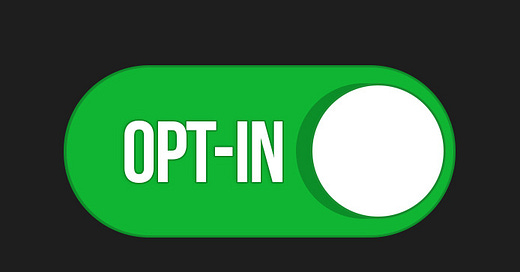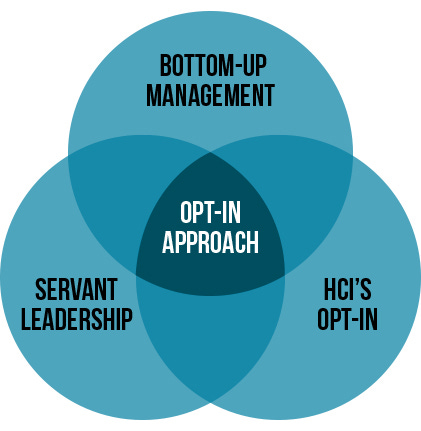Applying the Opt-In Approach to Building UX Influence in the Real World
How to Identify Allies and Manage Existing Responsibilities
Summary: In this post, we'll explore the Opt-In Approach, a practical framework for UX researchers to effectively build influence within their organizations. By identifying sympathetic coworkers and managing existing responsibilities, you can create meaningful collaborations that demonstrate the value of UX research. This guide will provide actionable steps to help you start small and track your successes as you grow your impact.
In an earlier blog post, I introduced a proven framework for expanding UX research's influence within organizations, which I called the Opt-In Approach. Here's a quick recap of the philosophy in case you missed the original post.
The Opt-In Approach is a straightforward, practical framework for UX researchers looking to naturally boost their impact within their organizations. It's built on the ideas of Bottom-Up Management, Servant Leadership, and HCI's user opt-in concept. This approach is all about engaging people who already see the value in UX, no hard selling required.
It encourages voluntary involvement and focuses on working with folks who are already in your corner. By following these principles, you can promote authentic teamwork and grow your influence smoothly and organically. This method works great in a variety of settings, from fast-moving startups to large tech companies. If you'd like to learn more about the Opt-In Approach, feel free to go back and read the original post here.
After I published the first article on the Opt-In Approach, I received requests for more details on how to apply this theory in the real world. Readers asked for more specifics on how to implement the strategy while managing their current workloads and identifying cross-functional UX research advocates, which they see as the biggest barriers to entry. In this post, I'll guide you through finding your first set of Opt-In partners without dropping the ball on your existing responsibilities.
Step 1: Find Your First Sympathetic Coworkers
The key to getting the Opt-In Approach off the ground is starting with a few coworkers who already value UX research or are at least curious about it. This doesn't mean walking into a room and declaring, "Who's with me on this UX research thing?" Instead, it's about subtlety, observation, and patience. So how do you identify these research-curious folks?
Pay Attention to Cross-functional Teams
Keep your ear to the ground during cross-functional meetings or casual conversations. Who's asking questions about user needs? Who's interested in learning how users interact with the product? It might not be obvious at first, but UX advocates tend to slip out of the woodwork when they hear you talk about users. These are the people you want to target for early collaborations.
Look for People with Frustrations
Sometimes, the best allies are the ones with the biggest problems. Pay attention to coworkers who regularly voice frustrations about user feedback, customer complaints, or usability issues.
They might not yet realize that UX research is the answer to their problems, but with the right nudge, they could become your strongest advocates.
Offer to help solve a problem they've been wrestling with, and you'll have a quick win on your hands.
Build on Existing Relationships
If you've already got solid relationships with a few teammates who "get it," start there. It's always easier to gain momentum with people who already trust you and understand what you bring to the table. Use them as your testing ground for the Opt-In Approach, and let their success stories do the heavy lifting when you're ready to scale to other teams.
Step 2: Start Small and Quietly Build Momentum
Once you've identified your first few sympathetic coworkers, it's time to get started quietly, without making too much noise. Remember, the Opt-In Approach is all about helping people where they are already at and demonstrating value through results, not declarations. So, rather than sending out a mass email about your robust UX research initiatives, start with small, low-stakes projects.
Choose a Project You Know Will Succeed
You don't want to kick things off with a massive, complex research study. Instead, choose a manageable project, ideally one where you already know UX research can have a tangible impact. This could involve user testing for a specific feature, analyzing existing data to improve an existing workflow, or conducting targeted usability tests to address a known pain point.
The goal here is to secure a quick win that demonstrates clear, measurable results.
Let Success Speak for You
As these small projects succeed, word will start to spread. People love results, and nothing convinces like a good success story. Once you've got a few under your belt, more people will start coming to you with questions or asking for your input. That's when you'll know the Opt-In Approach is working. Your influence will grow organically without having to constantly pitch the value of UX research to uninterested parties.
Step 3: Managing Your Existing Commitments
Now, what if you've got a lot on your plate already? One of the biggest concerns I hear from UX researchers is, "How can I start using the Opt-In Approach without dropping the ball on my current work?" Fair question, but good news, you don't have to choose between the two.
Prioritize Your Projects
The first step is to look at your existing projects and prioritize them. What's urgent? What's impactful? What's just busy work? Once you have a clear sense of where your time is currently going, you can decide where to focus your energy.
If your plate is full of less impactful projects, this might be a good time to have a conversation with your manager about cutting back. You can present the Opt-In Approach as a way to focus your efforts on high-value collaborations that produce better outcomes.
Use the Opt-In Approach to Replace Low-Value Work
A big part of the Opt-In Approach is about working smarter, not harder. If you're stuck doing a lot of work that doesn't feel meaningful or impactful, the Opt-In Approach can help shift your focus.
Over time, you can start transitioning from low-value, time-consuming tasks to higher-value, opt-in projects that deliver real results.
This shift won't happen overnight, but by documenting the success of your opt-in projects, you'll have a stronger case for focusing your time and energy on these types of initiatives moving forward.
Step 4: Saying "No" (Without Actually Saying It)
A critical part of managing the Opt-In Approach is knowing when to say no. This can be tough, especially if you're the kind of person who feels like they need to prove UX's value at every opportunity (spoiler alert: you don't). However, saying no doesn't have to be confrontational or awkward.
Offer Alternatives
When someone approaches you with a project that doesn't align with the Opt-In Approach, or you know won't be a good fit, try offering alternatives. For example, you could suggest a more efficient way to tackle the issue, offer a quick heuristic evaluation, or connect them with resources that don't require your deep involvement. Learning to delegate is a superpower that can open up your schedule in ways you might not even be able to imagine.
Be Transparent About Your Capacity
If you're already fully booked with opt-in projects, be upfront about your bandwidth. It's better to set expectations early than to overpromise and underdeliver. Plus, being clear about your time constraints sends a message that your time is valuable, which further reinforces the Opt-In Approach.
The beauty of the Opt-In Approach is that it helps identify areas that need UX research better than conducting an organization-wide audit. The effort is ongoing and organized, so if you're tasked with non-opt-in projects that take precedence, that's fine.
You can always pivot and come back to your Opt-In style work afterward.
In my experience, the percentage of non-opt-in to opt-in projects shifts over time once the impact and value start to become apparent. If you're good at your job, soon enough, almost all incoming requests will fall under the opt-in category. This is what I meant in the first article when I described it as self-fulfilling and a virtuous cycle.
Step 5: Tracking and Celebrating Wins
Finally, one of the most crucial parts of making the Opt-In Approach work is tracking and celebrating your wins. This isn't about boasting; it's about showing your team and leadership that UX delivers real, measurable results. The more success stories you have, the easier it will be to bring more teams on board.
Document Results as You Go
Whether it's user feedback, metrics like task completion time, or even just a quote from a satisfied stakeholder, make sure you're documenting the impact of your opt-in projects. Keep it simple. There's no need for a massive case study. A few bullet points, a simple chart, or an anecdotal user video clip will do.
The key here is to track your progress over time for comparison purposes. This is called benchmarking and is essential for demonstrating the UX researcher's impact. You may not need to show the progress for a while, but having that data ready to pull out when needed is the most critical part of showcasing real-world results under the Opt-In philosophy.
Share Success Stories Casually
When appropriate, share these success stories publicly in casual conversations, digital channels like Slack, or even in team meetings.
Frame them as "here's what we learned" rather than "look at what I did."
The more you can present these wins as collaborative efforts, the more likely others will want to join in on future projects. When you sing the praises of your cross-functional allies to the entire organization, you are rewarding positive behaviors and encouraging others to jump on board.
Conclusion
Starting the Opt-In Approach doesn't have to be an all-or-nothing commitment. By identifying your first sympathetic coworkers, starting with manageable projects, and keeping track of your successes, you'll start to build influence naturally. And while you may still need to juggle existing commitments, the more you use the Opt-In Approach, the more you'll be able to shift your focus toward high-impact, collaborative work.
Remember, it's not about forcing anyone to see the value of UX research. It's about working with those who already care and letting the results speak for themselves. Good luck, and as always, I'd love to hear how it goes for you!










